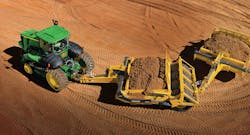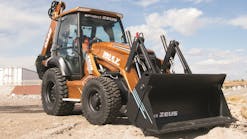“We used to hand-dig potholes to find utilities,” says O.G. Morrison, president of Bear Contractors Inc., an underground contractor based in West, TX. “But about two years ago, we bought a hydroexcavation machine. Depending on soil conditions, that machine can dig twice as many potholes in a day as you can dig by hand. Now we can’t afford not to have it. We find that it’s cheaper to stop and locate utilities than to hit them and have to pay for damages.”Utility strikes, nevertheless, happen by the thousands in the course of underground construction. In fact, some 12,000 strikes occurred in Colorado in 2002, says Gregg Austin, product safety and compliance engineer with Vermeer Manufacturing Co. in Pella, IA.To avoid such strikes—and prevent damage to utilities—more and more contractors are turning to hydroexcavation or vacuum excavation machines. Indeed, Occupational Safety & Health Administration rule 29 CFR 1926.651 requires contractors to expose all utilities before digging or drilling—and safety demands it.Hydroexcavation machines come in trailer-mounted or truck-mounted models. They rely on a high-pressure water pump, which feeds one or more nozzles for blasting away soil, sand, and even some types of rock. Frequently a hand-held “water knife,” working at 2,000 psi or more, is used to dig holes or slots in the ground. The water creates a slurry, which is sucked up by a high-powered vacuum system. In some cases, the water nozzles are attached to the vacuum hose. The resulting slurry of water and debris goes to a debris tank, which typically is hundreds of gallons in capacity.Some machines combine both hydroexcavation and sewer cleaning by water jetting and vacuum suction. “All of our sewer cleaning equipment can do hydroexcavation, but not all of our hydroexcavation machines are equipped to do sewer cleaning,” says Steve Schoenberger, president of Vector Technologies Ltd., a Milwaukee, WI–based manufacturer. Vector’s combination machine has both a 35-gpm pump for sewer cleaning and a 4-gpm pump for hydroexcavation, but hydroexcavation needs only the smaller pump.Hydroexcavation has its roots in the petroleum industry, where it has been used for years to expose—with no damage—underground oil pipelines and valves. “Now hydroexcavation has spread to finding all kinds of utilities—especially fiber optics, which has a high cost of repair,” says Dan Hutchison, operations manager for Badger Daylighting Inc. in Pittsboro, IN.Exponential Growth
By most reports, growth in the hydroexcavation business is at least steady and perhaps stronger. As more contractors learn what hydroexcavation can do, they are finding that its benefits—in utility strikes and damages avoided—more than outweigh its costs.
By most reports, growth in the hydroexcavation business is at least steady and perhaps stronger. As more contractors learn what hydroexcavation can do, they are finding that its benefits—in utility strikes and damages avoided—more than outweigh its costs.
The quiet-running FX30 Vacuum Extraction System with compact vacuum tank“Hydroexcavation is a safe way of excavating in a place where you have sensitive utility lines,” says Tom Jody, marketing manager for Vac-Con Inc., a manufacturer based in Green Cove Springs, FL. “You can use hydroexcavation machines for everything from digging out curb boxes to potholing to general trenching. Hydroexcavation has grown exponentially in the last five years because it does no damage to underground utilities.”Recent, rapid growth is evident at a franchise of Badger Daylighting, Badger of Western Wyoming. Just since 2000, the number of hydroexcavation trucks owned by the franchise has jumped from one to five, says Mike Hughes, owner and operator of the Big Piney, WY, company. Business has jumped fivefold. “We uncover fiber optics, electrical lines, telephone lines—anything buried underground,” says Hughes. “We’ve gone down to 30 feet deep.”One recent Badger project involved locating utilities under a potential road used to haul in extremely heavy windmill equipment. Ultimately the project will result in bringing 80 new power-generating windmills to Evanston, WY. The windmill equipment was heavy enough that hauling it in could damage underground gas lines, so the road had to be built up to protect the underground lines.“We took two trucks and three days to do that job,” says Hughes. “Each truck located 16 to 18 utility lines per day. We went down 6 to 12 feet deep, working in conjunction with the gas company.”Another project by Badger of Western Wyoming entailed cutting a slot 12 ft. deep and 6 in. wide in the shape of a football field. For a natural-gas plant expansion, Williams Field Service wanted to find all utilities crossing the boundary into the football-field-sized area, Hughes says.“We reslotted the area,” he continues. “After we excavated, we found some gas lines that prevented [Williams Field Service] from putting the new plant where [it] had planned. So we cut a new area about half the size of a football field. We’d use a mirror to reflect the sunlight down into the slot to see the utilities.”Costly Utility Damage
Hydroexcavation contractors say the process is considerably more costly than using a backhoe—but a lot less expensive than utility damage. “You’ve got to have a potholing machine,” says Craig Cleveland, vice president of Diversified Underground Inc., a contractor in Fayetteville, GA, “because if you hit something, you may as well just leave your machine where it sits. You’re going to lose a big chunk of what you’ve got.” Cleveland’s choice is a Ditch Witch FX30 hydroexcavation machine.Just how much does hydroexcavation cost? At Hydrovac Inc., a contractor based in Boca Raton, FL, Jim Derks owns two Vac-Con hydroexcavation trucks. One has an 80-gpm water pump, a 1,300-gal. water tank, and a 12-yd.3 debris tank. The other is a smaller machine with an 8-yd.3 debris tank. Derks says one truck can cost up to $2,000/day, depending on soil conditions and the situation. “Our hydroexcavation business has probably increased 20% to 30% in the past two years,” he notes.Not long ago, Hydrovac was called upon to install an underground pump room for stormwater drains at a condominium building in Deerfield Beach, FL. Because the site was close to the ocean, the water table was just 4 ft. below grade, yet the pump room was situated 22–24 ft. down. Hydrovac stood a section of 96-in.-diameter concrete pipe on end and then used hydroexcavation to carve out the sand around and inside the pipe. As the pipe section sank into the sand, a tower crane would hoist another pipe section into place atop the previous one, and the process was repeated until design depth was reached.“We worked mostly on the inside of the pipe,” says Derks. “The water volumes were so high that we used a 6-inch hydraulic water pump to assist the hydroexcavation machine. When we got down to depth, we poured an 18-inch-thick concrete floor into the bottom of the shaft—under water—and then pumped the water out. That was their pump room. It took about five days to place the pipe.”Derks cites another challenging project at the Diplomat Hotel in Hollywood, FL. The task was to dig a number of holes for 20-ft.-long light poles. Each light pole required a 48-in.-diameter base reaching about 4–6 ft. deep. “It was like a bowl of spaghetti underground,” says Derks. “You could not dig without destroying one utility or another. We would hydroexcavate a hole, and if we found a utility, we would move the hole over. It was a huge hotel, and we were on-site for three months. Seldom did we dig a hole that we didn’t have to move more than once. Even though it was an expensive operation, we saved [the hotel] a fortune in utility repairs.”He also recalls the time Hydrovac worked for an electric utility that had been auguring a 48-in.-diameter hole for a light-pole base in Stuart, FL. “They got down to 24 feet, and the hole caved in and broke off the auger bit,” says Derks. “They called me, and we took a 20-foot-long by 6-foot-diameter pipe and stood it on end over the spot. We vacuumed out the ground inside of it and sunk this 20-foot pipe until we found the auger. We lowered a man inside the pipe, he wrapped a choker around the auger, and we pulled the auger out.“They put the light pole in the same hole. We got down 24 feet, and the light poles were 200 feet long. The project took two days. They just filled the shaft with concrete.” For that project, Derks used his smaller machine, a Vac-Con unit with a 50-gpm, 2,500-psi water pump. Mounted on an International chassis, the machine has a 1,000-gal. water tank.Finding the Leaks
Randy Yeager tells the story of how hydroexcavation helped rescue a broken sewer line at a major shopping mall in the Denver, CO, area. Last March, Yeager’s company, Badger Daylighting Rocky Mountain in Brighton, CO, was called in to find the leak—under the mall’s interior—in a 6-in. sewer line. Badger used a hydroexcavation machine to bore a 2-ft.-wide by 6-ft.-deep trench under the mall, along the alignment of the sewer pipe.“The tunnel was 80 feet long,” Yeager recalls. “We used shoring and temporary lighting and the whole works. We could only work at night. It took 55 hours of hydroexcavating, and at $200 an hour, our bill was $11,000.“[The sewer line] had several leaks,” says Yeager. “We found one at 30 feet, and then we ran a camera into the sewer line to inspect it and found several more bad spots. We ran the trench back to competent pipe and replaced all of the bad pipe.”Yeager, whose company operates four Badger trucks, has also done hydroexcavation at the $1.67 billion T-REX project in the Denver area. It’s a combined highway and transit construction project and requires drilling foundation caissons in areas with underground utilities. “An auger digs the caissons to within 10 horizontal feet of a utility line, and then we do the ones where there’s a utility conflict,” Yeager says.“We’ll do caissons 3 feet in diameter and 20 feet deep. We’ve probably dug 15 to 20 caisson holes.” In tough digging, he adds, each caisson hole costs up to $3,200 because such holes take longer to dig.Care With Water Pressure
Tougher digging naturally demands higher water pressures, Yeager notes, but once the line is reached, high pressures for an excessive dwell time can damage certain utilities. In tests of water pressure against certain utilities, Yeager has discovered that, say, blasting 1,500 psi of water for 10 seconds can injure the old rubber asphalt coatings used on gas lines placed in the 1950s and 1960s. But for new polyethylene pipe covering new phone cable, blasting 2,200 psi of water for 30 seconds does no damage.“Lower pressure is always better,” says Yeager. “We have a pressure pop-off valve that won’t let pressure go above 2,200 psi. If we’ve got hard shale, we’ll turn the pressure up. The three-jet system that Badger has is less likely to damage a utility than [is] a single-jet system.”Sand is easy to hydroexcavate and requires lower water pressure. “You can almost vacuum it up without any water, but you need the water to help it flow,” Yeager says. “For sandy clay, you’d set it at 1,000 to 1,500 psi. And here in Denver, we have some hard shale, which takes 2,200 psi, and even that doesn’t do very well. You have to flake it off, and it takes a lot of water. It’s taken us a day to dig 20 feet in shale.“Some people can go to 5,000 psi, but they don’t have any better luck in shale than we do,” Yeager observes. Badger, it is noted, makes larger, truck-mounted hydroexcavation machines and is a franchise operation. Badger’s vacuum trucks move 5,000 cfm of air. “Our machines can suck up 10 cubic yards of pea gravel in eight minutes,” he adds.As evidence of hydroexcavation’s growing popularity, industry officials point to the fact that both Vermeer Manufacturing and The Charles Machine Works (i.e., Ditch Witch)—which are major underground-equipment manufacturers—now make hydroexcavation machines. Both companies make two trailer-mounted units.
At Ditch Witch, the FX30 was introduced in January 2002, and the FX60 came out a year later. Both machines feature water tanks of either 500, 800, or 1,200 gal. and offer water pressures up to 3,500 psi. The difference between the two is that the FX60 has a much more powerful vacuum system that can move 950 cfm.Vermeer offers the E550 and E900 potholing machines. The two are capable of delivering 1,000 cfm, and with a multinozzle wand system, both vacuum excavation units can pothole using a 4.5-gpm, 3,500-psi onboard pressure pump. Vermeer says its systems can be skid- or trailer-mounted.Yes, hydroexcavation is expensive, says Badger’s Dan Hutchison. “But what cost can you put on an accident?” he wonders. “As word spreads about hydroexcavation, more and more people will use it to avoid damage to utilities.”
Hydroexcavation contractors say the process is considerably more costly than using a backhoe—but a lot less expensive than utility damage. “You’ve got to have a potholing machine,” says Craig Cleveland, vice president of Diversified Underground Inc., a contractor in Fayetteville, GA, “because if you hit something, you may as well just leave your machine where it sits. You’re going to lose a big chunk of what you’ve got.” Cleveland’s choice is a Ditch Witch FX30 hydroexcavation machine.Just how much does hydroexcavation cost? At Hydrovac Inc., a contractor based in Boca Raton, FL, Jim Derks owns two Vac-Con hydroexcavation trucks. One has an 80-gpm water pump, a 1,300-gal. water tank, and a 12-yd.3 debris tank. The other is a smaller machine with an 8-yd.3 debris tank. Derks says one truck can cost up to $2,000/day, depending on soil conditions and the situation. “Our hydroexcavation business has probably increased 20% to 30% in the past two years,” he notes.Not long ago, Hydrovac was called upon to install an underground pump room for stormwater drains at a condominium building in Deerfield Beach, FL. Because the site was close to the ocean, the water table was just 4 ft. below grade, yet the pump room was situated 22–24 ft. down. Hydrovac stood a section of 96-in.-diameter concrete pipe on end and then used hydroexcavation to carve out the sand around and inside the pipe. As the pipe section sank into the sand, a tower crane would hoist another pipe section into place atop the previous one, and the process was repeated until design depth was reached.“We worked mostly on the inside of the pipe,” says Derks. “The water volumes were so high that we used a 6-inch hydraulic water pump to assist the hydroexcavation machine. When we got down to depth, we poured an 18-inch-thick concrete floor into the bottom of the shaft—under water—and then pumped the water out. That was their pump room. It took about five days to place the pipe.”Derks cites another challenging project at the Diplomat Hotel in Hollywood, FL. The task was to dig a number of holes for 20-ft.-long light poles. Each light pole required a 48-in.-diameter base reaching about 4–6 ft. deep. “It was like a bowl of spaghetti underground,” says Derks. “You could not dig without destroying one utility or another. We would hydroexcavate a hole, and if we found a utility, we would move the hole over. It was a huge hotel, and we were on-site for three months. Seldom did we dig a hole that we didn’t have to move more than once. Even though it was an expensive operation, we saved [the hotel] a fortune in utility repairs.”He also recalls the time Hydrovac worked for an electric utility that had been auguring a 48-in.-diameter hole for a light-pole base in Stuart, FL. “They got down to 24 feet, and the hole caved in and broke off the auger bit,” says Derks. “They called me, and we took a 20-foot-long by 6-foot-diameter pipe and stood it on end over the spot. We vacuumed out the ground inside of it and sunk this 20-foot pipe until we found the auger. We lowered a man inside the pipe, he wrapped a choker around the auger, and we pulled the auger out.“They put the light pole in the same hole. We got down 24 feet, and the light poles were 200 feet long. The project took two days. They just filled the shaft with concrete.” For that project, Derks used his smaller machine, a Vac-Con unit with a 50-gpm, 2,500-psi water pump. Mounted on an International chassis, the machine has a 1,000-gal. water tank.Finding the Leaks
Randy Yeager tells the story of how hydroexcavation helped rescue a broken sewer line at a major shopping mall in the Denver, CO, area. Last March, Yeager’s company, Badger Daylighting Rocky Mountain in Brighton, CO, was called in to find the leak—under the mall’s interior—in a 6-in. sewer line. Badger used a hydroexcavation machine to bore a 2-ft.-wide by 6-ft.-deep trench under the mall, along the alignment of the sewer pipe.“The tunnel was 80 feet long,” Yeager recalls. “We used shoring and temporary lighting and the whole works. We could only work at night. It took 55 hours of hydroexcavating, and at $200 an hour, our bill was $11,000.“[The sewer line] had several leaks,” says Yeager. “We found one at 30 feet, and then we ran a camera into the sewer line to inspect it and found several more bad spots. We ran the trench back to competent pipe and replaced all of the bad pipe.”Yeager, whose company operates four Badger trucks, has also done hydroexcavation at the $1.67 billion T-REX project in the Denver area. It’s a combined highway and transit construction project and requires drilling foundation caissons in areas with underground utilities. “An auger digs the caissons to within 10 horizontal feet of a utility line, and then we do the ones where there’s a utility conflict,” Yeager says.“We’ll do caissons 3 feet in diameter and 20 feet deep. We’ve probably dug 15 to 20 caisson holes.” In tough digging, he adds, each caisson hole costs up to $3,200 because such holes take longer to dig.Care With Water Pressure
Tougher digging naturally demands higher water pressures, Yeager notes, but once the line is reached, high pressures for an excessive dwell time can damage certain utilities. In tests of water pressure against certain utilities, Yeager has discovered that, say, blasting 1,500 psi of water for 10 seconds can injure the old rubber asphalt coatings used on gas lines placed in the 1950s and 1960s. But for new polyethylene pipe covering new phone cable, blasting 2,200 psi of water for 30 seconds does no damage.“Lower pressure is always better,” says Yeager. “We have a pressure pop-off valve that won’t let pressure go above 2,200 psi. If we’ve got hard shale, we’ll turn the pressure up. The three-jet system that Badger has is less likely to damage a utility than [is] a single-jet system.”Sand is easy to hydroexcavate and requires lower water pressure. “You can almost vacuum it up without any water, but you need the water to help it flow,” Yeager says. “For sandy clay, you’d set it at 1,000 to 1,500 psi. And here in Denver, we have some hard shale, which takes 2,200 psi, and even that doesn’t do very well. You have to flake it off, and it takes a lot of water. It’s taken us a day to dig 20 feet in shale.“Some people can go to 5,000 psi, but they don’t have any better luck in shale than we do,” Yeager observes. Badger, it is noted, makes larger, truck-mounted hydroexcavation machines and is a franchise operation. Badger’s vacuum trucks move 5,000 cfm of air. “Our machines can suck up 10 cubic yards of pea gravel in eight minutes,” he adds.As evidence of hydroexcavation’s growing popularity, industry officials point to the fact that both Vermeer Manufacturing and The Charles Machine Works (i.e., Ditch Witch)—which are major underground-equipment manufacturers—now make hydroexcavation machines. Both companies make two trailer-mounted units.
At Ditch Witch, the FX30 was introduced in January 2002, and the FX60 came out a year later. Both machines feature water tanks of either 500, 800, or 1,200 gal. and offer water pressures up to 3,500 psi. The difference between the two is that the FX60 has a much more powerful vacuum system that can move 950 cfm.Vermeer offers the E550 and E900 potholing machines. The two are capable of delivering 1,000 cfm, and with a multinozzle wand system, both vacuum excavation units can pothole using a 4.5-gpm, 3,500-psi onboard pressure pump. Vermeer says its systems can be skid- or trailer-mounted.Yes, hydroexcavation is expensive, says Badger’s Dan Hutchison. “But what cost can you put on an accident?” he wonders. “As word spreads about hydroexcavation, more and more people will use it to avoid damage to utilities.”







